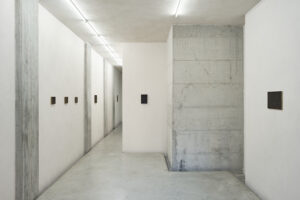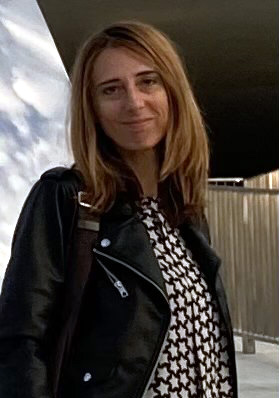Chinese artist Bu Shi (Yunnan, China 1993) with a double degree in painting obtained respectively at the College of Fine Arts in Sichuan and in Visual Arts at the Academy of Fine Arts in Bologna returns, after having exhibited in the group show Sine Qua Non on the occasion of he eighth edition of Opentour, in the spaces of CAR DRDE with the solo show The dream of the black chamber.

Bu Shi, The dream of the black chamber, installation view at CAR Gallery, courtesy CAR Gallery, Bologna
The title, as stated in the critical text accompanying the exhibition written by Emanuela Zanon, «paraphrases the essential eighteenth-century classic of Chinese literature The dream of the red chamber (…) whose atmospheres served as an imprint to enter Bu Shi’s paintings and to approach his aesthetic philosophy, synthesized as a distillation of visual delicacies that seem to proliferate one from the other almost by budding and which derive from the reworking of the artistic repertoires from the Eastern and Western traditions(…)». The dream of the black chamber refers at the same time to the small and precious diptych present in the exhibition, where in the left panel, a raku ceramic bowl is depicted, that is, made using a particular clay firing technique that condenses the ideal of imperfect and transitory beauty of the Wabi-Sabi, and from which emerges the tail of an animal, while in the one on the right, the self-portrait of the artist appears in the foreground with a landscape in the background.

Bu Shi, Inverted fires, 2023, tempera painting on wooden panel, courtesy CAR Gallery, Bologna
A dozen unpublished small pieces, mostly water tempera on silk-polished wood (with the exception of two works on canvas mounted on a wooden support), host interior scenes and landscape miniatures. The latter is a very widespread and appreciated theme in traditional Chinese painting full of profound meanings; think of the Shanshui hua genre and its landscapes characterized by mountains and rivers in a naturalism with mystical connotations which, in line with Taoist and Buddhist principles, follows the rules of balance, composition and form. Here the high and strong mountains representing the yang, silhouetted towards the sky and for this reason considered by the ancient abodes of the immortals, stand on land crossed by streams of water, soft and flowing representing the yin.

Bu Shi, Earth, water, fire, wind, 2023, tempera painting on wooden panel, courtesy CAR Gallery, Bologna
Some works on display, celebrating the great western masters from the past revisited with an Oriental sensitivity, seem to materialize Japanese haiku: similarly to the strongly evocative yet extremely synthetic verse compositions, a few magnetizing objects, arranged harmoniously in space, rhythmically cadence the vision, opening up poetic and mysterious universes. Still lifes pay homage to that essentiality that reconnects us to certain atmospheres typical of Morandi’s paintings together with a metaphysics with a de Chirico flavor.

Bu Shi, The dream of the chrysalis, 2023, tempera painting on wooden panel, courtesy CAR Gallery, Bologna
The works enclose a temporal freeze that makes the hic et nunc of everyday life a privileged and absolute moment of an enigmatic unfolding of visions provoked by mirrors that multiply points of view, paintings within paintings with windows that frame landscapes and which create openings onto others worlds, shots of rooms that collect objects largely belonging to the artist’s personal collection in a concentration of details that emerge from the surface and gradually reveal themselves to the viewer and sometimes shine thanks to the gilded motifs next to them or to the painting itself fixed with lacquer Chinese.

Bu Shi, The loss of the memory (Three-mirror room), 2023, tempera painting on wooden panel, 18 x 23 cm, courtesy CAR Gallery, Bologna
Bu Shi’s favorite subjects, simple and often reiterated in the various mise en scène, inevitably end up becoming familiar to the viewer in an exercise of harmonic balance that looks like a practice of meditation. Miniaturized Zen gardens, crystals, fruit, glass vases, eggs, shells, pictures, lacquered and decorated boxes, also portrayed alone as the unique and mysterious protagonists of the composition, make up modern wunderkammer sometimes framed by strips of curtains, sixteenth-seventeenth century heritage, simulating curtains on scenes of private life. Bu Shi prefers dark colors, almost as if the scenarios came from an unconscious world or connected us to parallel dimensions where black full moons float on dark skies.

Bu Shi, The dream of the black chamber (Raku), 2023, tempera painting on wooden panel, 13 x 20 cm (diptych), courtesy CAR Gallery, Bologna
The artist draws with black; an engulfing black that attracts the viewer’s attention and defines its objects, volumes and spaces. An absolute color, from which everything originates, an element with a strong fascination often linked to chthonic forces. It is no coincidence that the most recurring theme in Bu Shi’s paintings is that of vanitas: candles, skulls, insects reappear from painting to painting, however sometimes associated with eggs, a symbol of prosperity and rebirth placed on finely chiseled pedestals and shells which, in addition to encompassing the aforementioned characteristics, synthesize superior knowledge.

Bu Shi, The dream of the black chamber, installation view at CAR Gallery, courtesy CAR Gallery, Bologna
Light bulbs and lighted candles enter these dark Caravaggesque compositions from time to time, always with a strong call to knowledge; luminous intermittences that stand in the way of atmospheres of gloomy suspended expectations. In many works, laterally to decorate the composition, a signature-seal appears, executed with ancient characters, in accordance with the centuries-old tradition of calligraphic art of his home country, and which as a distinctive trait emerging from these environments bathed in shadow, shakes our beliefs and invites us to explore what is not too certain.
Info:
Bu Shi. The dream of the black chamber
30.03-29.04.2023
CAR DRDE Gallery
Manifattura delle Arti- Via Azzo Gardino 14/A, Bologna
www.cardrde.com

After classical studies, she enrolled at the Faculty of Letters and Philosophy in Bologna, graduating in History of Cinema (DAMS) and later in Art History. She obtained a Master in Communication for cultural enterprises. Journalist and critic, she collaborates with various print and online magazines specialized in the artistic and cultural sector, including Finestre sull’Arte, Segno, Exibart, Zeta-International magazine of poems and research, Punto e Linea Magazine, Gagarin Orbite Culturali. She loves art in all its forms, preferring modern, contemporary and research.






NO COMMENT